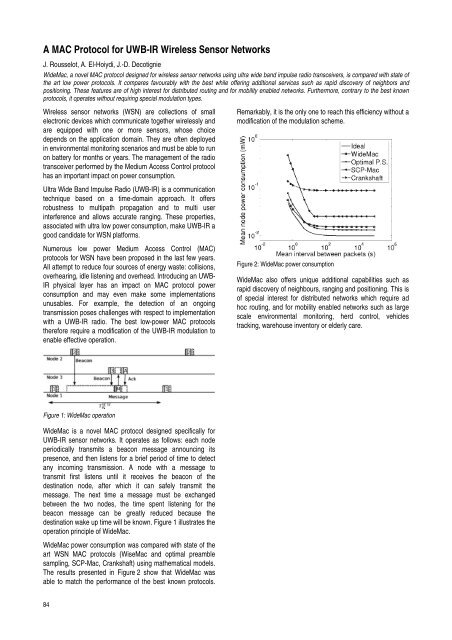research activities in 2007 - CSEM
research activities in 2007 - CSEM
research activities in 2007 - CSEM
Create successful ePaper yourself
Turn your PDF publications into a flip-book with our unique Google optimized e-Paper software.
A MAC Protocol for UWB-IR Wireless Sensor Networks<br />
J. Rousselot, A. El-Hoiydi, J.-D. Decotignie<br />
WideMac, a novel MAC protocol designed for wireless sensor networks us<strong>in</strong>g ultra wide band impulse radio transceivers, is compared with state of<br />
the art low power protocols. It compares favourably with the best while offer<strong>in</strong>g additional services such as rapid discovery of neighbors and<br />
position<strong>in</strong>g. These features are of high <strong>in</strong>terest for distributed rout<strong>in</strong>g and for mobility enabled networks. Furthermore, contrary to the best known<br />
protocols, it operates without requir<strong>in</strong>g special modulation types.<br />
Wireless sensor networks (WSN) are collections of small<br />
electronic devices which communicate together wirelessly and<br />
are equipped with one or more sensors, whose choice<br />
depends on the application doma<strong>in</strong>. They are often deployed<br />
<strong>in</strong> environmental monitor<strong>in</strong>g scenarios and must be able to run<br />
on battery for months or years. The management of the radio<br />
transceiver performed by the Medium Access Control protocol<br />
has an important impact on power consumption.<br />
Ultra Wide Band Impulse Radio (UWB-IR) is a communication<br />
technique based on a time-doma<strong>in</strong> approach. It offers<br />
robustness to multipath propagation and to multi user<br />
<strong>in</strong>terference and allows accurate rang<strong>in</strong>g. These properties,<br />
associated with ultra low power consumption, make UWB-IR a<br />
good candidate for WSN platforms.<br />
Numerous low power Medium Access Control (MAC)<br />
protocols for WSN have been proposed <strong>in</strong> the last few years.<br />
All attempt to reduce four sources of energy waste: collisions,<br />
overhear<strong>in</strong>g, idle listen<strong>in</strong>g and overhead. Introduc<strong>in</strong>g an UWB-<br />
IR physical layer has an impact on MAC protocol power<br />
consumption and may even make some implementations<br />
unusables. For example, the detection of an ongo<strong>in</strong>g<br />
transmission poses challenges with respect to implementation<br />
with a UWB-IR radio. The best low-power MAC protocols<br />
therefore require a modification of the UWB-IR modulation to<br />
enable effective operation.<br />
Figure 1: WideMac operation<br />
WideMac is a novel MAC protocol designed specifically for<br />
UWB-IR sensor networks. It operates as follows: each node<br />
periodically transmits a beacon message announc<strong>in</strong>g its<br />
presence, and then listens for a brief period of time to detect<br />
any <strong>in</strong>com<strong>in</strong>g transmission. A node with a message to<br />
transmit first listens until it receives the beacon of the<br />
dest<strong>in</strong>ation node, after which it can safely transmit the<br />
message. The next time a message must be exchanged<br />
between the two nodes, the time spent listen<strong>in</strong>g for the<br />
beacon message can be greatly reduced because the<br />
dest<strong>in</strong>ation wake up time will be known. Figure 1 illustrates the<br />
operation pr<strong>in</strong>ciple of WideMac.<br />
WideMac power consumption was compared with state of the<br />
art WSN MAC protocols (WiseMac and optimal preamble<br />
sampl<strong>in</strong>g, SCP-Mac, Crankshaft) us<strong>in</strong>g mathematical models.<br />
The results presented <strong>in</strong> Figure 2 show that WideMac was<br />
able to match the performance of the best known protocols.<br />
84<br />
Remarkably, it is the only one to reach this efficiency without a<br />
modification of the modulation scheme.<br />
Figure 2: WideMac power consumption<br />
WideMac also offers unique additional capabilities such as<br />
rapid discovery of neighbours, rang<strong>in</strong>g and position<strong>in</strong>g. This is<br />
of special <strong>in</strong>terest for distributed networks which require ad<br />
hoc rout<strong>in</strong>g, and for mobility enabled networks such as large<br />
scale environmental monitor<strong>in</strong>g, herd control, vehicles<br />
track<strong>in</strong>g, warehouse <strong>in</strong>ventory or elderly care.








